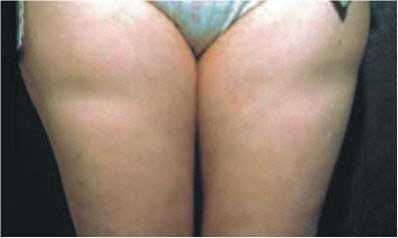Lipoatrophia semicircularis (L.s.) is an idiopathic condition characterized by semicircular impressions of the skin, usually at the front and sides of both thighs. It is characterized by atrophy of the subcutaneous adipocytes whereas the skin and muscles remain normal. L.s. was originally considered to be very rare but since 1995 an outburst of L.s. has been observed in companies in Belgium and later on also in companies in other countries (e.g., Spain) where several hundred individuals were diagnosed with L.s. All these subjects belonged to the administrative personnel and worked in renovated or new offices.
BBEMG research results: Lipoatrophia semi-circularis

A number of hypotheses were put forward in the literature or investigated in the afflicted companies. They involve the following aspects:
- Ergonomic factors and local pressure
- Local traumata (other than pressure)
- Diseases
- Indoor pollution
- Indoor climatic conditions: humidity, temperature
- Local thermal energy losses
- Electro-stimulation.
Many of these hypotheses are now ruled out. Our hypothesis of an “electric” origin of L.s. is now believed to be the most plausible [as for example reconfirmed at the International Conferences on Lipoatrophia semicircularis in Madrid, November 18, 2008 and Barcelona, September 16, 2009)] although it seems obvious that the lipoatrophic condition has a multifactorial origin from which electro-stimulation is a key element. Investigations on Lipoatrophia semicircularis were in the past performed in the framework of the BBEMG activities. The results can be found in three publications listed below.

Documents & Links
- Verschaeve L, Maes A. (2009).
In vitro investigations related to the hypothesis that Lipoatrophia semicircularis finds its origin in electro-stimulation.
J Appl Toxicol 29: 478-482. - Verschaeve L., Maes A. (2009).
Support for the hypothesis that electro-stimulation is responsible for Lipoatrophia semicircularis.
Med. Hypotheses 73: 802-806. - Maes A, Curvers B, Verschaeve L. (2003).
Lipoatrophia semicircularis: the electromagnetic hypothesis. Electromagnet Biol Med. 22:183–193.


